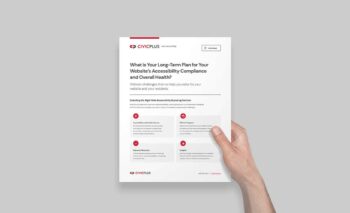Empowering Local Governments with Accessible Digital Forms: CivicPlus® Solutions in Action
As local governments increasingly transition to digital platforms for services such as permitting, applications, and public requests, the need for accessible forms has become critical.
However, many people don’t fully grasp how to achieve accessibility — and if they do, they’re overwhelmed by how time-consuming and complex the process can be.
Fortunately, software solutions can help agencies maintain compliance with accessibility laws, including the Americans with Disabilities Act (ADA), and WCAG 2.1 online accessibility standards. Here’s how.
The Growing Need for Accessible Digital Forms
About 95% of adults in the United States report using the internet, underscoring the importance of local governments having a strong online presence. This includes the use of digital forms.
Digital forms not only promote inclusivity but they can also streamline the user experience, increase reach, and help agencies boost trust and engagement while simultaneously improving operational efficiency and eliminating the burdens of paper-based processes.
In short, everyone wins.
Still, every resident must be able to easily access these documents. Ensuring compatibility with assistive technologies, offering auto-translations, and providing an intuitive user experience for those with limited tech literacy must be prioritized by agencies wanting to digitize forms.
Not only because it’s a moral imperative, but because it’s a legal one, too — and noncompliance can be costly.
Entities may be fined up to $75,000 for an initial ADA violation and $150,000 for subsequent ones. In addition, anyone can file a compliance lawsuit, leading to settlements of thousands of dollars.
The good news is that you don’t have to do this alone. Digital technologies can simplify the entire process, ensuring that accessibility features — including form validation, clear instructions, and automatic form completion — are integrated seamlessly with your website.
Read More: Enhance Web Accessibility with Software that Fosters Digital Equity
Best Practices for Accessible Digital Forms
Digital forms have many advantages, but it’s essential to be strategic about how you build them. Here are a few accessibility best practices to keep in mind:
- Consider Assistive Technology: Designing forms with inclusive features such as keyboard navigation, screen reader compatibility, and alternative text for form fields will help maintain accessibility for residents with disabilities.
- Optimize Text: Users of all backgrounds will have an easier time understanding clear, concise language as opposed to jargon. Direct language also makes forms easier to read, which is important for accessibility and engagement.
- Prioritize Readability: Lengthy paragraphs, vague labels, and CAPTCHA systems can alienate users with disabilities, making accessibility and compliance challenging. To create an inclusive experience, avoid these barriers and keep in mind that the average reading comprehension level in the U.S. is around 8th grade.
- Diligence Using PDFs: When using portable document files (PDFs), confirm the metadata, ensure color contrast meets standards, add appropriate alt-text to images, confirm lists are formatted correctly, tag tables, and verify compliance using a testing tool such as CommonLook.
How Digital Forms Have Improved the Civic Experience
When used correctly, digital forms have the power to transform agencies and communities. Such was the case in Manitou Springs, Colorado.
“We have a fair amount of tax forms that our businesses need to complete monthly,” said Alex Trefry, the city’s public information and engagement officer. “Previously, we were using PDFs that weren’t editable or easily accessible. A user would have to log on to our website, fill out the form, download it, print it, and email it in. We knew the process had room for improvement.”
Trefry recreated the paper forms using the CivicPlus® Process Automation system, building them to automatically calculate a user’s taxes based on submitted data. This helped eliminate errors, made the monthly process easier for residents, and freed up time for the city’s financial team.
Best of all, the process was seamless: “My degree is in political science, I work in communications, and math is not my strong suit, but I was still able to build the forms with the custom calculations pretty quickly,” Trefry said.
Read More: The Long-Term Benefits of Digital Accessibility for Local Government
Conclusion: The Future of Accessible Civic Websites and Forms
Nearly 30% of adults in the U.S. have a disability, and your department must be sure that everyone can access and engage with the forms on your website.
With the commitment-free CivicPlus Web Accessibility Checker, you can detect broken links, typos, and other errors to better understand what you can do to enhance your website’s performance.
It’s time to prioritize accessibility — and CivicPlus can help. Give us a call today, and let’s transform your website together.


